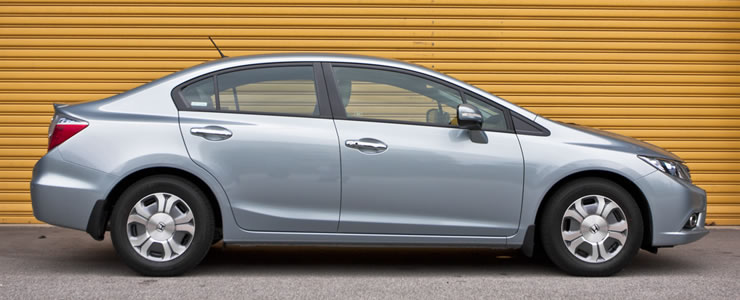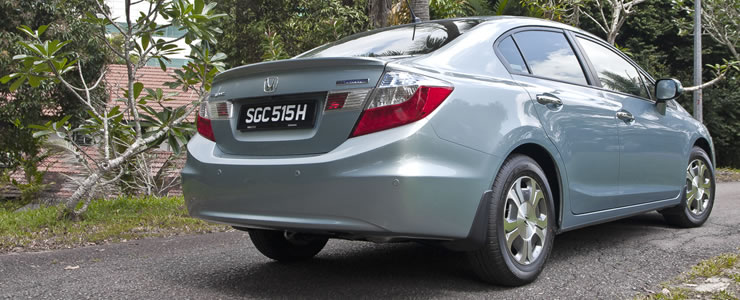Honda Civic Hybrid 1.5 (A) Review
08 Mar 2012|37,767 views
Hybrid: a bug that has seemingly caught up with carmakers, just like how we, at some point of our lives became addicted to computer games. And of course, there are advocates on either side: people who think that games aids in brain development; versus those who views them as a by-effect of electronics advancement.
So it is, at the end of the day, for us to determine if Hybrid cars do real good to the environment, or is a hidden-in-plain-sight killer of driving enjoyment.
In what Honda calls IMA (Integrated Motor Assist), the new Civic receives numerous tweaks over the previous hybrid, all it claims to be for the betterment of fuel efficiency. We find out if the switched focus impairs the driving delectation that is synonymous with Honda cars.
Exterior
Many would agree that the new Civic has seemingly undertaken a conservative route in its styling. And if your eyes perceive it as being smaller than its predecessor, they aren't playing tricks on you: the latest Civic indeed took a cut in its dimensions, most notably a 30mm shrink in its wheelbase.
So it is, at the end of the day, for us to determine if Hybrid cars do real good to the environment, or is a hidden-in-plain-sight killer of driving enjoyment.
In what Honda calls IMA (Integrated Motor Assist), the new Civic receives numerous tweaks over the previous hybrid, all it claims to be for the betterment of fuel efficiency. We find out if the switched focus impairs the driving delectation that is synonymous with Honda cars.
Exterior
Many would agree that the new Civic has seemingly undertaken a conservative route in its styling. And if your eyes perceive it as being smaller than its predecessor, they aren't playing tricks on you: the latest Civic indeed took a cut in its dimensions, most notably a 30mm shrink in its wheelbase.
 |
The front steep windscreen is a carried-over feature from the previous Civic, albeit more acutely-raked. In Honda's design language, the Civic inherits 'mono-block' styling, with chiselled features presented subtly around the body.
The hybrid Civic differentiates itself from its lesser-tech-advanced stablemates via a series of badges, and a solid front air intake with a stripe of reflector running across in clear turquoise. Both head and tail lamps surround sports similar turquoise hues, accentuating a futuristic outlook. And despite being fitted with smaller alloy rims (15-inch compared to 16-inch found on the 1.6), these visual bits does its part in making the hybrid no-less attractive than its less-frugal counterparts.
 |
Interior
Like its exterior, the new Civic's interior is more of an evolution than a revolution. The fuss-free three-spoke steering provides decent feel with adequate control functions accessible on each side. The bright 'IMA' signage and lack of paddles shifts serves as a reminder that it is the hybrid Civic you're piloting.
The re-designed two-tier instrument panel, which first found its way in the previous gen Civic, is one of the delightful features found in the present Civics. The well-received layout now incorporates Honda's multi-information display (i-MID) on the top tier, sitting just to the left of the digital speedometer. This provides ease of reading even during driving. Useful readouts, such as the remaining range on fuel, and the source of drive (electric motor or engine) can be selected via a steering-mounted switch. Interestingly, there is also an eco-meter which gauges the driving efficiency of the user.
Like its exterior, the new Civic's interior is more of an evolution than a revolution. The fuss-free three-spoke steering provides decent feel with adequate control functions accessible on each side. The bright 'IMA' signage and lack of paddles shifts serves as a reminder that it is the hybrid Civic you're piloting.
The re-designed two-tier instrument panel, which first found its way in the previous gen Civic, is one of the delightful features found in the present Civics. The well-received layout now incorporates Honda's multi-information display (i-MID) on the top tier, sitting just to the left of the digital speedometer. This provides ease of reading even during driving. Useful readouts, such as the remaining range on fuel, and the source of drive (electric motor or engine) can be selected via a steering-mounted switch. Interestingly, there is also an eco-meter which gauges the driving efficiency of the user.
The hybrid packs another gadget which is usually found in more premium models - a 6.2-inch touch screen display. It serves as a user-interface for both entertainment and factory-fitted navigation system. Discerning users though, may find the interface a tad dated, with more simplistic graphics compared to those on the i-MID.
Both front and rear seats offers support and comfort, even for long hours of driving. Rear occupants will also find no trouble easing in the ride, with adequate head and leg room to match, which is an engineering feat by Honda considering that the wheelbase has been reduced.
Both front and rear seats offers support and comfort, even for long hours of driving. Rear occupants will also find no trouble easing in the ride, with adequate head and leg room to match, which is an engineering feat by Honda considering that the wheelbase has been reduced.
 |
The Drive
The Hybrid comes adeptly-equipped with standard keyless entry with remote boot release. Moving off the line, the motor-aided powertrain indeed feels more eager, with more accessible torque through the lower rev-band. At some instances though, the hybrid seems a little 'breathless' when insufficient revs are given during cruising, resulting in low-note engine murmurs.
Give it more revs and the engine's response belie that of a hybrid. The engine is much livelier; playing a soundtrack which makes the other hybrids seems plain and boring at that instance. However, do not be taken into thinking that the 1.5 hybrid is a straight-line performer, as the power figures on paper would suggest otherwise.
Technically, Honda's IMA system differs slightly from other hybrid systems on the market. Although the hybrid motor assists the engine during propulsion, the motor is not single-handedly responsible for providing the drive at any given instances, a feature which can be found on its 'closest' rival, the Toyota Prius.
When it comes to handling, the well-weighted steering, combined with the slightly-stiffer springs instils confidence in the driver. The down-side to the mature handling is that the car feels less nimble, especially around tighter corners in urban areas.
The Hybrid comes adeptly-equipped with standard keyless entry with remote boot release. Moving off the line, the motor-aided powertrain indeed feels more eager, with more accessible torque through the lower rev-band. At some instances though, the hybrid seems a little 'breathless' when insufficient revs are given during cruising, resulting in low-note engine murmurs.
Give it more revs and the engine's response belie that of a hybrid. The engine is much livelier; playing a soundtrack which makes the other hybrids seems plain and boring at that instance. However, do not be taken into thinking that the 1.5 hybrid is a straight-line performer, as the power figures on paper would suggest otherwise.
Technically, Honda's IMA system differs slightly from other hybrid systems on the market. Although the hybrid motor assists the engine during propulsion, the motor is not single-handedly responsible for providing the drive at any given instances, a feature which can be found on its 'closest' rival, the Toyota Prius.
When it comes to handling, the well-weighted steering, combined with the slightly-stiffer springs instils confidence in the driver. The down-side to the mature handling is that the car feels less nimble, especially around tighter corners in urban areas.
Conclusion
The latest Civic Hybrid is proof of Honda's efforts in seeking continual improvements. With priorities deeply rooted for better efficiency, the Civic does seem to struggle in other aspects such as the mediocre exterior styling, especially when its Korean competitors are upping their games both aesthetically and in the level of equipments offered.
See it in a different light then; what the hybrid offers is real capability which is more than skin-deep. As the saying goes "there is a kid in every man", there is no harm to keep up with current trends and indulge once now and then, does it?
The latest Civic Hybrid is proof of Honda's efforts in seeking continual improvements. With priorities deeply rooted for better efficiency, the Civic does seem to struggle in other aspects such as the mediocre exterior styling, especially when its Korean competitors are upping their games both aesthetically and in the level of equipments offered.
See it in a different light then; what the hybrid offers is real capability which is more than skin-deep. As the saying goes "there is a kid in every man", there is no harm to keep up with current trends and indulge once now and then, does it?
Hybrid: a bug that has seemingly caught up with carmakers, just like how we, at some point of our lives became addicted to computer games. And of course, there are advocates on either side: people who think that games aids in brain development; versus those who views them as a by-effect of electronics advancement.
So it is, at the end of the day, for us to determine if Hybrid cars do real good to the environment, or is a hidden-in-plain-sight killer of driving enjoyment.
In what Honda calls IMA (Integrated Motor Assist), the new Civic receives numerous tweaks over the previous hybrid, all it claims to be for the betterment of fuel efficiency. We find out if the switched focus impairs the driving delectation that is synonymous with Honda cars.
Exterior
Many would agree that the new Civic has seemingly undertaken a conservative route in its styling. And if your eyes perceive it as being smaller than its predecessor, they aren't playing tricks on you: the latest Civic indeed took a cut in its dimensions, most notably a 30mm shrink in its wheelbase.
So it is, at the end of the day, for us to determine if Hybrid cars do real good to the environment, or is a hidden-in-plain-sight killer of driving enjoyment.
In what Honda calls IMA (Integrated Motor Assist), the new Civic receives numerous tweaks over the previous hybrid, all it claims to be for the betterment of fuel efficiency. We find out if the switched focus impairs the driving delectation that is synonymous with Honda cars.
Exterior
Many would agree that the new Civic has seemingly undertaken a conservative route in its styling. And if your eyes perceive it as being smaller than its predecessor, they aren't playing tricks on you: the latest Civic indeed took a cut in its dimensions, most notably a 30mm shrink in its wheelbase.
 |
The front steep windscreen is a carried-over feature from the previous Civic, albeit more acutely-raked. In Honda's design language, the Civic inherits 'mono-block' styling, with chiselled features presented subtly around the body.
The hybrid Civic differentiates itself from its lesser-tech-advanced stablemates via a series of badges, and a solid front air intake with a stripe of reflector running across in clear turquoise. Both head and tail lamps surround sports similar turquoise hues, accentuating a futuristic outlook. And despite being fitted with smaller alloy rims (15-inch compared to 16-inch found on the 1.6), these visual bits does its part in making the hybrid no-less attractive than its less-frugal counterparts.
 |
Interior
Like its exterior, the new Civic's interior is more of an evolution than a revolution. The fuss-free three-spoke steering provides decent feel with adequate control functions accessible on each side. The bright 'IMA' signage and lack of paddles shifts serves as a reminder that it is the hybrid Civic you're piloting.
The re-designed two-tier instrument panel, which first found its way in the previous gen Civic, is one of the delightful features found in the present Civics. The well-received layout now incorporates Honda's multi-information display (i-MID) on the top tier, sitting just to the left of the digital speedometer. This provides ease of reading even during driving. Useful readouts, such as the remaining range on fuel, and the source of drive (electric motor or engine) can be selected via a steering-mounted switch. Interestingly, there is also an eco-meter which gauges the driving efficiency of the user.
Like its exterior, the new Civic's interior is more of an evolution than a revolution. The fuss-free three-spoke steering provides decent feel with adequate control functions accessible on each side. The bright 'IMA' signage and lack of paddles shifts serves as a reminder that it is the hybrid Civic you're piloting.
The re-designed two-tier instrument panel, which first found its way in the previous gen Civic, is one of the delightful features found in the present Civics. The well-received layout now incorporates Honda's multi-information display (i-MID) on the top tier, sitting just to the left of the digital speedometer. This provides ease of reading even during driving. Useful readouts, such as the remaining range on fuel, and the source of drive (electric motor or engine) can be selected via a steering-mounted switch. Interestingly, there is also an eco-meter which gauges the driving efficiency of the user.
The hybrid packs another gadget which is usually found in more premium models - a 6.2-inch touch screen display. It serves as a user-interface for both entertainment and factory-fitted navigation system. Discerning users though, may find the interface a tad dated, with more simplistic graphics compared to those on the i-MID.
Both front and rear seats offers support and comfort, even for long hours of driving. Rear occupants will also find no trouble easing in the ride, with adequate head and leg room to match, which is an engineering feat by Honda considering that the wheelbase has been reduced.
Both front and rear seats offers support and comfort, even for long hours of driving. Rear occupants will also find no trouble easing in the ride, with adequate head and leg room to match, which is an engineering feat by Honda considering that the wheelbase has been reduced.
 |
The Drive
The Hybrid comes adeptly-equipped with standard keyless entry with remote boot release. Moving off the line, the motor-aided powertrain indeed feels more eager, with more accessible torque through the lower rev-band. At some instances though, the hybrid seems a little 'breathless' when insufficient revs are given during cruising, resulting in low-note engine murmurs.
Give it more revs and the engine's response belie that of a hybrid. The engine is much livelier; playing a soundtrack which makes the other hybrids seems plain and boring at that instance. However, do not be taken into thinking that the 1.5 hybrid is a straight-line performer, as the power figures on paper would suggest otherwise.
Technically, Honda's IMA system differs slightly from other hybrid systems on the market. Although the hybrid motor assists the engine during propulsion, the motor is not single-handedly responsible for providing the drive at any given instances, a feature which can be found on its 'closest' rival, the Toyota Prius.
When it comes to handling, the well-weighted steering, combined with the slightly-stiffer springs instils confidence in the driver. The down-side to the mature handling is that the car feels less nimble, especially around tighter corners in urban areas.
The Hybrid comes adeptly-equipped with standard keyless entry with remote boot release. Moving off the line, the motor-aided powertrain indeed feels more eager, with more accessible torque through the lower rev-band. At some instances though, the hybrid seems a little 'breathless' when insufficient revs are given during cruising, resulting in low-note engine murmurs.
Give it more revs and the engine's response belie that of a hybrid. The engine is much livelier; playing a soundtrack which makes the other hybrids seems plain and boring at that instance. However, do not be taken into thinking that the 1.5 hybrid is a straight-line performer, as the power figures on paper would suggest otherwise.
Technically, Honda's IMA system differs slightly from other hybrid systems on the market. Although the hybrid motor assists the engine during propulsion, the motor is not single-handedly responsible for providing the drive at any given instances, a feature which can be found on its 'closest' rival, the Toyota Prius.
When it comes to handling, the well-weighted steering, combined with the slightly-stiffer springs instils confidence in the driver. The down-side to the mature handling is that the car feels less nimble, especially around tighter corners in urban areas.
Conclusion
The latest Civic Hybrid is proof of Honda's efforts in seeking continual improvements. With priorities deeply rooted for better efficiency, the Civic does seem to struggle in other aspects such as the mediocre exterior styling, especially when its Korean competitors are upping their games both aesthetically and in the level of equipments offered.
See it in a different light then; what the hybrid offers is real capability which is more than skin-deep. As the saying goes "there is a kid in every man", there is no harm to keep up with current trends and indulge once now and then, does it?
The latest Civic Hybrid is proof of Honda's efforts in seeking continual improvements. With priorities deeply rooted for better efficiency, the Civic does seem to struggle in other aspects such as the mediocre exterior styling, especially when its Korean competitors are upping their games both aesthetically and in the level of equipments offered.
See it in a different light then; what the hybrid offers is real capability which is more than skin-deep. As the saying goes "there is a kid in every man", there is no harm to keep up with current trends and indulge once now and then, does it?
Car Information
Honda Civic Hybrid 1.5 (A)
CAT A|Petrol-Electric|22.7km/L
Horsepower
82kW (110 bhp)
Torque
174 Nm
Acceleration
-
This model is no longer being sold by local distributor
All Used Honda Civic HybridThank You For Your Subscription.














































